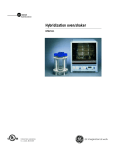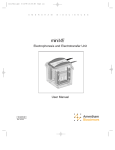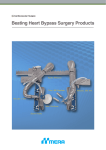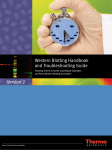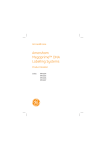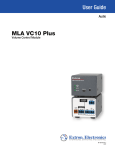Download GE RPN2510E User's Manual
Transcript
GE Healthcare Amersham Hybridization oven/shaker Product User Manual Codes:RPN2510E RPN2511E RPN2512E Page finder 1. Legal 3 2. Introduction 4 3. Safety warnings and precautions 3.1. Electrical Installation 5 5 4. Specification 6 5. 7 7 7 8 Setting up the Hybridization Oven/Shaker 5.1. Setting the oven temperature 5.2. Setting up the rotisserie 5.3. Setting up the platform shaker 6. Hybridization using the platform shaker 9 7. Hybridization using the rotisserie 7.1. Assembly of membranes into bottles 7.2. Hybridization 7.3. Membrane washing procedures 7.3.1. Radioactive Hybridizations 7.3.2. AlkPhos Direct Hybridizations 10 10 10 11 11 11 8. Maintenance/care/cleaning of the oven/shaker 8.1. Error codes/faults 12 12 9. Troubleshooting guide 13 Appendix 1. Products for electrophoresis 14 Appendix 2. Hybond membranes for nucleic acid applications 15 Appendix 3. Radioactive labeling systems 16 Appendix 4. Non-radioactive labeling and detection systems 17 Appendix 5. Products for autoradiography and chemiluminscent detection 18 Appendix 6. Hybridization buffer 19 Appendix 7. Radiation safety products 20 RPN2510EUM Pagefinder Rev C 06/2007 2 1. Legal GE, imagination at work and GE monogram are trademarks of General Electric Company. Amersham, Alkphos Direct, ECF, ECL, ECL Plus, ECL Advance, Hybond, Hypercassette, Hyperfilm, Hyperscreen, Hypertorch, Megaprime, Nick, Rapidhyb, Ready-To-Go, Rediprime, Sensitive and Trackertape are trademarks of GE Healthcare companies. All third party trademarks are the property of their respective owners. © 2003–2007 General Electric Company – All rights reserved. First published November 2003 All goods and services are sold subject to the terms and conditions of sale of the company within GE Healthcare which supplies them. A copy of these terms and conditions is available on request. Contact your local GE Healthcare representative for the most current information. http://www.gehealthcare.com/lifesciences GE Healthcare UK Limited. Amersham Place, Little Chalfont, Buckinghamshire, HP7 9NA UK RPN2510EUM Chapter 1 Rev C 06/2007 3 2. Introduction One of the most widely used techniques in the molecular biology field is the immobilization of DNA and RNA onto a solid support membrane and subsequent hybridizations with a specific single stranded probe, labeled to facilitate its detection. Using the GE Healthcare Hybridization Oven/Shaker ensures that the temperature and shaking/rotation frequency, and hence the stringency of hybridization and washing steps are rigidly controlled. This enables rapid and reproducible probing of nucleic acids, and proteins immobilized on nylon and nitrocellulose membranes. The GE Healthcare Hybridization Oven/Shaker is a multipurpose instrument combining accurate temperature control with a choice of interchangeable hybridization modes: • V ariable speed rotisserie: holding 7 × 40 mm or 2 × 75 and 2 × 40 mm hybridization bottles. • A variable speed platform shaker for ‘box’ hybridizations, depurination, denaturation and neutralization steps. The instrument is: • E conomical: bottle hybridization minimizes probe volumes, reducing reagent volumes and enhancing signal intensity. • P recise: stringency of hybridization and washing steps are rigidly controlled, ensuring reproducible results. • S ensitive: validated protocols ensure optimal hybridization and washing steps, enhancing multiple reprobing when using Hybond™ membranes. • S afe: the double-glazed polycarbonate/acrylic door offers excellent thermal insulation whilst minimizing radiation exposure. • Convenient: small foot-print maximizes the use of limited laboratory space. The instrument is suitable for use in conjunction with radiolabeled probes using Rapid-hyb™ buffer, non-radioactive nucleic acid labeling and detection systems such as AlkPhos Direct™, and protein labeling and detection systems including ECL™, ECL Plus™ and ECL Advance™. Some protocols for use with these applications are included in section 7. RPN2510EUM Chapter 2 Rev C 06/2007 4 3. Safety warnings and precautions If the equipment is not used in the manner described in this manual the protection provided might be impaired This equipment is designed to operate under the following conditions: For indoor use only Use in a well ventilated area Ambient temperature range + 5°C to + 40°C Altitude to 2000 m Relative humidity not exceeding 80% Mains supply fluctuation not exceeding 10% Over-voltage category II IEC60364-4-443 Pollution degree 2 Use with a minimum distance all around of 200 mm from walls or other items The unit should be carried using both hands. Never move or carry the unit when in use or connected to the mains electricity supply. In the case of mains interruption, a fault or electrical failure, the unit will continue to operate on restoration of the electricity supply or removal of the fault. 3.1. Electrical Installation WARNING: Lethal voltages inside the Hybridization Oven casing. Always switch the Hybridization Oven/Shaker off and remove the plug from the electrical socket before performing any cleaning or maintenance of the instrument. THIS INSTRUMENT MUST BE EARTHED IMPORTANT: The Hybridization Oven/Shaker has been supplied with a cordset and plug. Check that the appropriate plug for your electrical supply has been included. If there is any doubt consult a qualified electrician and inform your local GE Healthcare sales office. Should the plug require replacement in the future, the following information should be noted: The wires in the mains lead are coloured in accordance with the following code: GREEN/YELLOW Earth BLUE Neutral BROWN Live As the colours of the wires in the mains lead of this item may not correspond with the coloured markings identifying the terminals in your plug, proceed as follows: • T he wire which is coloured green/yellow must be connected to the terminal in the plug which is marked with the letter ‘E’ or by the earth symbol or colours green or green/yellow. • T he wire, which is coloured blue, must be connected to the terminal, which is marked with the letter ‘N’ or coloured black. • T he wire, which is coloured brown, must be connected to the terminal, which is marked ‘L’ or coloured red. • F it the plug with the appropriate fuse. Always replace the plug cover, never use the plug without the cover. The GE Healthcare Hybridization Oven/Shaker is intended for research use only and not for any other purpose. RPN2510EUM Chapter 3 Rev C 06/2007 5 IF IN DOUBT CONSULT A QUALIFIED ELECTRICIAN 4. Specification Overall dimensions Height: Depth: Width: 17” 15” 15” (43.5 cm) (38.0 cm) (38.0 cm) 8” 9” 10” (20.0 cm) (23.0 cm) (25.0 cm) Oven dimensions Height: Depth: Width: Weight: 24 kg Capacity (nominal): 18 litres Temperature range: Ambient plus 5°C–80°C Temperature precision: +/- 0.5°C Temperature fluctuation: +/- 0.1°C (@37°C) Power rating: 250 W Over temperature cut-out: 1°C over set temperature Temperature variation: < 0.25°C Rotisserie speed: 2–10 rev/minute Shaker platform speed: 5–70 strokes/minute Electrical Nominal Voltage/Hertz/Amp 230 V / 50 Hz / 3.1 A 110/120 V / 60 Hz / 4 A 100 V / 50/60 Hz / 4 A Product code RPN2510E RPN2511E RPN2512E Each instrument is supplied with 1 rotisserie (RPN2514), 6 hybridization bottles (RPN2516) and an instruction manual. Accessories Rotisserie, holds 7 × 40 mm hybridization bottles RPN2514 Rotisserie, holds 2 × 75 mm and 2 × 40 mm hybridization bottles RPN2515 Hybridization bottle, 260 × 40 mm (For rotisserie RPN2514, pack of 6) RPN2516 Hybridization bottle, 170 × 40 mm (For rotisserie RPN2514, pack of 6) RPN2517 Hybridization bottle, 240 × 75 mm (For rotisserie RPN2515, pack of 2) RPN2518 Hybridization mesh, 1 roll 21.5 cm × 10 m RPN2519 RPN2510EUM Chapter 4 Rev C 06/2007 6 5. Setting up the Hybridization Oven/Shaker 1.Remove all packaging and place the Hybridization Oven/Shaker on a level working surface, ensuring that there is sufficient room above the instrument to allow the door to be opened fully. 2.Leave the unit to stand for a minimum of 3 hours. This will allow acclimation to the new ambient temperature. 3.Plug the female end of the power cable into the Hybridization Oven/Shaker. 4.Connect the power cable to a suitably grounded electrical outlet. The correct operating voltage of the Hybridization Oven/Shaker is found on the product information label on the rear of the instrument. 5. Turn the Mains ON/OFF switch (1 on Fig 1) to the ON position. 6. The GE Healthcare Hybridization Oven/Shaker is now ready for use. 1 2 3 4 5 6 7 Rotisserie 45 30 4 on off Temperature ( °C) 6 8 15 60 2 5 0 rotisserie (rev/minute) 10 on press off to set 70 shake r (strokes/minute) Hybridisation Oven/Shaker Fig 1. Diagram of instrument control panel 5.1. Setting the oven temperature 1.The Oven temperature controls are located on the right hand side of the control panel (numbers 4 to 7 in figure 1). 2.To turn the temperature control ON press the on / off button (4). The LED display (6) will show the current Oven temperature. 3.To set the temperature, press and hold the press to set button (5) and at the same time rotate the temperature selector dial (7) until the required temperature is shown on the digital display (6). 4.Release the press to set button (5) and the temperature display (6) will revert back to the actual Oven temperature. Rotisserie/shaker controls 1. Rotisserie/shaker ON/OFF button 2. Rotisserie/shaker speed selector dial 3. Motor on indicator Temperature controls 4. Temperature on/off button 5. Press to set button 6. LED temperature display 7. Temperature selector dial 5.The set temperature can be viewed at any time simply by pressing and holding the press to set button (6) 6. The oven will now automatically heat up to the set temperature. 5.2. Setting up the rotisserie Note: the Oven is fitted with automatic digital over-temperature protection (see Section 8.1. for more details). The rotisserie is installed in the Hybridization Oven/Shaker during transit. To use the rotisserie for bottle hybridization, the following procedure should be adopted: 1.Lift up the oven door to its fullest extent to allow complete access to the oven interior. 2.Lift the rotisserie vertically out of the oven. Unpack and place on the bench. 3.Place the membranes to be hybridized into the required number of hybridization bottles. Using the rotisserie as a stand for the bottles, place the bottles into the rotisserie, pushing them down as far as they will go. RPN2510EUM Chapter 5 Rev C 06/2007 7 NOTE: Always ensure that the weight is evenly distributed on both sides of the rotisserie. Place an empty hybridization bottle into the other side of the rotisserie as a counterbalance if necessary. 4.Place the rotisserie into the oven onto the rotation mechanism, ensuring that the serrated bands at either end of the rotisserie locate onto the steel cogs of the rotation mechanism at the rear of the oven. (B on figure 2). The plastic flanges of the rotisserie locate on to the small wheels on the oven floor. Close the oven door. 5.Ensure that the desired temperature has been set (see section 5.1). 6.The speed controls are on the left hand side of the control panel (numbers 1 to 3 in figure 1). Turn the Rotisserie/Shaker ON by pressing the on / off button (1). The red indicator light (3) above the speed selector dial (2) will illuminate. 7.Turn the Rotisserie/Shaker speed selector dial (2) clockwise until the desired rotation speed is reached (allowable values are 2–10 rpm). The rotisserie will now start to rotate at the set speed. 8.When hybridization is complete turn the Rotisserie/Shaker OFF by pressing the on / off button (1). The red indicator (3) will go out. 5.3. Setting up the platform shaker During transit, the platform is stored vertically at the rear of the oven chamber. It can remain in this position whilst the rotisserie is in use. To use the platform shaker for ‘sandwich box’ hybridizations, the following procedure should be adopted: 1. Open the oven door to its fullest extent, lift the rotisserie vertically and store in a safe place. 2.Lift the platform by its handle (A, see figure 2) from its storage position, slide it forward and locate it on the rocking mechanism by placing the side pegs of the platform into the retainers (D) on the side walls of the oven chamber. This action seats the nylon blocks (C) on the underside of the platform on to the pegs (E) protruding from the rocker mechanism at the rear of the oven. 3.Place the box in which the hybridization is being performed on to the shaker platform and close the oven door. 4.Ensure that the desired temperature has been set (see section 4.1). 5.Turn the Rotisserie/Shaker ON by pressing the on / off button (1). The red indicator light (3) above the speed selector dial (2) will illuminate. 6.Rotate the Rotisserie/Shaker speed selector dial (2) clockwise, until the desired shaker speed is reached. Allowable values are 5–70 strokes per minute. The shaker platform will now oscillate at the set speed. 7.When hybridization is complete turn the Rotisserie/Shaker OFF by pressing the on / off button (1). The red indicator will go out (3). C B A B Fig 2. Hybridization oven drive components C D D E RPN2510EUM Chapter 5 Rev C 06/2007 8 6. Hybridization using the platform shaker The Hybridization Oven/Shaker is compatible with the hybridization technologies available from GE Healthcare. These include radioactive hybridizations using Rapid hyb buffer and the range of non-radioactive systems for the labelling and detection of proteins and nucleic acids (see appendix 1). When using the platform shaker the hybridization and washing conditions recommended in the appropriate GE Healthcare literature should be used. The following protocol therefore provides a guideline. For specific hybridization times and temperatures, refer to the relevant protocol booklet. 1.Prepare blots as recommended in the appropriate Hybond protocol booklet. 2. Set the oven temperature as described in section 5.1. 3.Place the membrane in a suitable box (or bag) and cover with sufficient prehybridization buffer to ensure that the entire surface of the membrane is covered. Recommended volume: surface area ratio is given in most protocol booklets. Seal the box (or bag) securely. 4.Place the box (or bag) on the platform, set the oscillation speed to 30 strokes/ minute as described in section 5.3. Prehybridize for the required length of time. 5.Remove the box (or bag) from the oven and carefully add the labeled single stranded probe (denaturation may be required post labelling refer to the appropriate protocol booklet) to the prehybridization buffer. 6.Reseal the box (or bag) securely, replace it on the platform and hybridize for the required length of time. 7.Remove the membranes and place in a clean box containing the first stringency wash solution. 8.Increase the oscillation speed of the platform to 60 strokes/minute. Carry out the recommended washing protocol at the appropriate temperature and for the appropriate times. RPN2510EUM Chapter 6 Rev C 06/2007 9 NOTE: Do not pipette the probe solution directly on to the membrane as this may cause localized background. 7. Hybridization using the rotisserie Several advantages are associated with performing hybridizations in bottles, namely those of safety and economy as outlined in the introduction. However, the use of bottles for hybridizations and washing procedures requires certain adaptations to standard protocols. 7.1. Assembly of membranes into bottles 1.Add approximately 20 ml 2 × SSC buffer into the hybridization bottle. The rotisserie acts as a convenient bottle stand. 2.Pre-wet the membrane in 2 × SSC buffer and loosely roll it up. 3.Insert the rolled up membrane into the bottle and replace the cap. Ensure that the cap is screwed on securely, (hand tight plus a quarter turn). DO NOT OVERTIGHTEN, or the thread of the cap can be damaged, leading to leakages. NOTE: If placing several small blots into one bottle, prewet the membranes as above, and space them out along the length of the bottle with forceps. 4. Place the bottle on a flat surface and roll it gently in the opposite direction to that in which the membrane is coiled. This rolling action causes the membrane to uncoil, so lining the inner surface of the bottle. NOTE: The use of a mesh in bottle hybridizations to ensure uniform contact between the membrane surface and the buffer has been recommended. However, studies at GE Healthcare laboratories using a wide range of hybridization mesh technologies demonstrate a resulting loss of sensitivity due to partial absorption of the probe into the mesh. A nylon mesh (RPN2519) is available as an optional extra, as it can facilitate easier handling of a number of blots and the more fragile nitrocellulose membranes. These handling advantages should be considered against the potential loss of sensitivity before use. When a hybridization mesh is used in conjunction with the membrane, the following procedure should be adopted: 5.Pre-wet the mesh alongside the membrane in 2 × SSC buffer and place the prewetted membrane on top of the mesh. The mesh should be slightly larger than the blot in all dimensions. Roll both up together, with the mesh on the outside of the membrane, and insert into the bottle as described above (7.1.4.). 7.2. Hybridization 1.Set the required oven temperature as detailed in section 5.1. 2.Discard the 2 × SSC, used in the bottle to unroll the membrane, and replace with prehybridization buffer. Recommended volumes are provided in most GE Healthcare protocol booklets. Generally a minimum of 10–15 ml per 20 × 20 cm blot is advised. Seal the bottle, avoiding overtightening. 3.Place the hybridization bottle(s) into the rotisserie (as detailed in section 5.2.) add counterbalance bottles if necessary. Place the rotisserie into the oven so that the bottles are rotating in the same direction as the membrane is rolled, see Figure 3. Fig 3. Rotation of rotisserie rotation of membrane RPN2510EUM Chapter 7 Rev C 06/2007 10 4. Prehybridize the membrane for the specified length of time at a rotisserie speed of 4 rpm. 5. Following prehybridization, turn off the rotisserie, remove the rotisserie from the oven. Add the labeled probe to the buffer, either by removing an aliquot of the buffer, adding the probe and returning the aliquot to the bottle; or by adding the probe directly into the bottle, avoiding the membrane. 6. Hybridize for the specified length of time at a rotisserie speed of 4 rpm. 7.3. Membrane washing procedures Membranes can either be removed from the hybridization bottles and washed in a box on the platform shaker (this is a more efficient procedure), or the washing procedure may be carried out in the bottles. If the platform shaker is used, follow the standard washing procedure mentioned in the appropriate protocol booklet. If bottles are to be used it is necessary to modify the standard washing procedure. Outlined in this section are the optimized washing protocols for radioactive hybridizations and non-radioactive based hybridizations. 7.3.1. Radioactive Hybridizations 1.Carefully drain off the hybridization buffer, rinse the bottle and the membrane thoroughly with 2 × SSC and discard. 2.Perform the following stringency washes in large volumes (100 ml minimum) of the following solutions, at a rotisserie speed of 8 rpm: 2 × 10 minutes with 2 × SSC, 0.1% SDS at 65°C 1 × 15 minutes with 1 × SSC, 0.1% SDS at 65°C 2 × 10 minutes with 0.1 × SSC, 0.1% SDS at 65°C NOTE: This last step is a high stringency wash and should be omitted if related sequences are to be probed. (More washes over the same time period for each stringency condition can improve background). 3.Remove the membrane from the bottle, drain off excess stringency wash, wrap in SaranWrap™ and autoradiograph. 7.3.2. AlkPhos Direct Hybridizations 4.Drain off the hybridization buffer, rinse the bottle and the membrane thoroughly with primary wash buffer and discard. 5.Perform the following stringency washes in large volumes (100 ml minimum) of the following solutions, at a rotisserie speed of 8 rpm: 3 × 10 minutes with primary wash buffer solution at 55°C 3 × 5 minutes with secondary wash buffer at room temperature 6.Remove the membrane from the bottle and detect using the standard procedures outlined in the protocol booklet. RPN2510EUM Chapter 7 Rev C 06/2007 11 NOTE: The room temperature washes can be achieved by switching off the oven and leaving the door open whilst performing the washes or by allowing the oven to cool down to room temperature before performing the final washes. 8. Maintenance/care/cleaning of the oven/shaker The GE Healthcare Hybridization Oven/Shaker is designed to provide trouble-free operation. The base of the oven and the shaker tray act as a spills tray and will contain any spillage that occurs during hybridization and washing procedures. To ensure lasting operation the following instructions should be followed: ALWAYS DISCONNECT THE HYBRIDIZATION OVEN/SHAKER FROM THE ELECTRICAL SUPPLY BEFORE CLEANING OR DRYING THE INSTRUMENT. 1.Any leakage from the hybridization bottles or the sandwich boxes should be cleaned up immediately. Do not allow any liquids to enter the drive mechanism. 2.Wipe away any liquids from inside and outside of the unit using soap and water with a soft cloth or sponge. 3. Do not allow chemicals to remain on unit surfaces. 4. Never clean unit with abrasive pads or cleaners. 5. Never clean unit with acetone or chloroform. Only spare parts supplied or specified by GE Healthcare or its agent should be used. Fitting of non-approved parts may affect the performance of the safety features designed into the instrument. 8.1. Error codes/faults The Oven has built in fault diagnostics. If a fault occurs, this system will display an error code in the LED display to help the service engineer rectify the problem. Please see the table below for details of error codes and other faults. In the unlikely event that a problem does occur, note down which code / fault you observe and contact your nearest GE Healthcare Office for further assistance. If you have your own service personnel available for repair, a comprehensive service manual is available on request. Fault Safety system in operation Fault displayed by Temperature probe PT100 reading low Automatic over-temp system activated LED displays Err and 0.1 alternatively Temperature probe PT100 reading high Automatic over-temp system activated LED displays Err and 0.2 alternatively Secondary relay control activated Top left dot flashes in display Triac fault Rotisserie / shaker motor stalled Cuts power to motor No movement seen but Rotisserie red indicator light still on Software crash No temperature or motor motor power, all LED’s blank RPN2510EUM Chapter 8 Rev C 06/2007 Cuts mains power 12 9. Troubleshooting guide This section briefly summarizes some of the potential problems encountered during membrane hybridizations. More complete troubleshooting guides are supplied in the pack leaflet that accompany each product. Symptom Cause Remedy 1. Membrane curling up in hybridization bottle 1.1. Incorrect orientation of bottle in rotisserie 1.1. Ensure membrane is rolled up in the same direction as the bottle is rotating (see section 7.2) 2. High background 2.1. Probe concentration too high 2.1. Reduce probe concentration 2.2. Unincorporated 32P nucleotides not removed 2.2. Remove unincorporated nucleotides 2.3. Insufficient blocking 2.3. Use recommended hybridization buffer or extend prehybridization time 2.4. Insufficient washing 2.4. Increase number of buffer changes during the washing stage or increase stringency of final wash 3.1. No transfer from gel to membrane 3.1. Load extra lanes with control DNA. Transfer can be checked by restaining gel with ethidium bromide. If large DNA fragments are detected poorly, use a depurination step (0.25 M HCI) 3.2. Probe not labeled 3.2. Check probe labelling before hybridization. See protocol in probe labelling booklet 3.3. Probe not denatured 3.3. Boil probe for 5 minutes before adding to hybridization buffer 3.4. Low specific activity of probe 3.4. Review labelling conditions 3.5. Washes too stringent 3.5. Increase buffer salt concentration and decrease temperature 4.1. Hybridization buffer or wash solution not evenly covering membrane 4.1. Increase volume of hybridization wash or solutions or use mesh (see section 7.1. step 4) 4.2. Damaged membrane 4.2. Handle membrane carefully with forceps 5.1. Damaged membrane 5.1. Use clean scissors or a sharp scalpel to cut membrane 3. Weak signal 4. Patchy backgrounds 5. High background around edge of membrane RPN2510EUM Chapter 9 Rev C 06/2007 13 Appendix 1. Products for electrophoresis DNA Markers Precise Sizing Digest of Natural DNAs 50 Base-pair 100 Base-pair ladder ladder 27-4005-01 27-4007-01 KiloBase DNA marker 27-4004-01 DRigest III 27-4060-01 500a 2000a 10000 23130b 450 1900 8000 9416 400 1800 6000 6557 350 1700 5000 4361b 300 1600 4000 2322 250 1500 3000 2027 200 1400 2500 1353 150 1300 2000 1078 100 1200 1500 872 50 1100 1000 603 1000 500 564d 900 310 800 281 700 271 600 234 500 194 400 125c 300 118 200 72 100 a not necessarily the largest size fragment possible, only the largest that is readily distinguishable b cos ends are located on these bands c may not always be visible Marker code number Recommended gel Loading amount (µg/lane) Heat before loading 27-4005-01 2% agarose/6% polyacrylamide 2.0 No 27-4007-01 1.5% agarose 2.0 No 27-4004-01 0.8% agarose 0.5 No 27-4060-01 1% agarose 0.5–1.0 60–65°C for 2 minutes RPN2510EUM Appendix 1 Rev C 06/2007 14 Appendix 2. Hybond membranes for nucleic acid applications Size 82 mm 87 mm 132 mm 137 mm 82 mm 87 mm 132 mm 137 mm 30 × 50 cm 9 × 10 cm 10 × 10 cm 15 × 20 cm 20 × 20 cm 22.2 × 22.2 cm 14 × 16 cm 12 × 10 cm 15 × 10 cm 6 × 8 cm 7 × 8 cm 11.9 × 7.8 cm 22.2 × 22.2 cm 22.5 × 22.5 cm 115 × 73 mm 20 cm × 3 m 30 cm × 3 m 30 cm × 3 m Pack size Hybond N+ Hybond XL Hybond N Hybond NX Hybond ECL Hybond C Extra Hybond P 50 discs RPN82B RPN82S RPN82N RPN82T RPN82D RPN82E 50 discs RPN87B RPN87S RPN87N RPN87T 50 discs RPN132B RPN132S RPN132N RPN132T RPN132D 50 discs RPN137B RPN137S RPN137N RPN137T RPN137E 50 gridded discs RPN1782B 50 gridded discs RPN1787B 50 gridded discs RPN1732B 50 gridded discs RPN1737B 5 sheets RPN3050B RPN3050S RPN3050N 10 sheets RPN910D 10 sheets RPN1010D 10 sheets RPN1520B RPN1520S RPN1520N RPN1520T RPN1520D 10 sheets RPN2020B RPN2020S RPN2020N RPN2002T RPN2020D RPN2020E RPN2020F 10 sheets RPN2222B RPN2222S RPN2222N 15 sheets RPN1416F 20 sheets RPN1210B RPN1210S RPN1210N 20 sheets RPN1510B RPN1510S RPN1510N 50 sheets RPN68D 50 sheets RPN78D 50 sheets RPN119B RPN119S RPN119N 50 sheets RPN2250B 50 sheets RPN225B 50 sheets RPN1576B 1 roll RPN203B RPN203S RPN203N RPN203D RPN203E 1 roll RPN303B RPN303S RPN303N RPN303T RPN303D RPN303E RPN303F a 1 roll RPN3032D a = 0.2 µm pack size RPN2510EUM Appendix 2 Rev C 06/2007 15 Appendix 3. Radioactive labeling systems Labelling Technology Nucleotide Amount of Labelling system template time Probe specific activity (dpm/µg) Recommended application Product code Rediprime™ II Random-prime dCTP only 25 ng 10 minutes 2 × 109 membrane hybridization RPN1633 RPN1634 Ready-To-Go™ Random-prime dCTP only 10 ng–1 µg 5 minutes 2 × 109 DNA labelling beads membrane hybridization DNA labelling Megaprime™ Random-prime any dNTP 25 ng 10 minutes 2 × 109 membrane hybridization Nick translation Nick translation any dNTP 1 µg 2–3 hours 2 × 109 RPN2510EUM Appendix 3 Rev C 06/2007 16 production of large amounts of probe 27-9240-01 RPN1604 RPN1605 RPN1606 RPN1607 N5000 N5500 Appendix 4. Non-radioactive labeling and detection systems Labelling and detection Sensitivity system Time from Duration of hybridization light output to detection Strip before Quantification Recommended application re-probing AlkPhos Direct (RPN3690) 0.06 pg 1 hour 5 days yes no Single copy Southern and Northerns ECL Direct (RPN3000) 0.5 pg 1 hour 1–2 hours no no High target applications eg. colony/plaques RPN2510EUM Appendix 4 Rev C 06/2007 17 Appendix 5. Products for autoradiography and chemiluminscent detection Hyperfilm – high performance autoradiography films Product description Hyperfilm ECL Hyperfilm ECL Hyperfilm ECL Hyperfilm ECL Hyperfilm ECL Hyperfilm ECL Hyperfilm ECL Hyperfilm MP Hyperfilm MP Hyperfilm MP Hyperfilm MP Hyperfilm MP Hyperfilm MP Hyperfilm MP Hyperfilm MP Enveloped size number sheets code 5 × 7 inches 18 × 24 cm 18 × 24 cm 8 × 10 inches 8 × 10 inches 24 × 30 cm 35 × 43 cm 5 × 7 inches 18 × 24 cm 18 × 24 cm 8 × 10 inches 8 × 10 inches 24 × 30 cm 35 × 43 cm 18 × 24 cm 50 50 100 50 100 50 50 50 50 100 50 100 50 50 50 28-9068-35 28-9068-36 28-9068-37 28-9068-38 28-9068-39 28-9068-40 28-9068-41 28-9068-42 28-9068-43 28-9068-44 28-9068-45 28-9068-46 28-9068-47 28-9068-48 28-9068-50 Hypercassette™ – cassettes for autoradiography and light detection Size 18 × 24 cm 24 × 30 cm 30 × 40 cm 35 × 43 cm 18 × 43 cm 20 × 40 cm 5 × 7 inches 8 × 10 inches 10 × 12 inches Code (standard) Code (deep) RPN11642 RPN11643 RPN11644 RPN11645 RPN11646 RPN11647 RPN11648 RPN11649 RPN11650 RPN11628 RPN11627 RPN11629 Hyperscreen™ – intensifying screens for 32P and 125I autoradiography Size 18 × 24 cm 24 × 30 cm 30 × 40 cm 35 × 43 cm 18 × 43 cm 20 × 40 cm 5 × 7 inches 8 × 10 inches 10 × 12 inches Code Quantity RPN1662 RPN1663 RPN1664 RPN1665 RPN1666 RPN1667 RPN1668 RPN1669 RPN1670 1 pair 1 pair 1 pair 1 pair 1 pair 1 pair 1 pair 1 pair 1 pair Related Products Product name Description Code Hypertorch™ Sensitize™ Battery powered LED darkroom torch, pack of 3 Optimized preflash system RPN1620 RPN2051 RPN2510EUM Appendix 5 Rev C 06/2007 18 Appendix 6. Hybridization buffer Product name Rapid-Hyb buffer Rate enhanced hybridization buffer for use with radiolabelled nucleic acid probes RPN2510EUM Appendix 6 Rev C 06/2007 Pack size Code 125 ml 500 m RPN1635 RPN1636 19 Appendix 7: Radiation safety products Product Description Product Dimensions Quantity Code Number CDC storage box 240 × 140 × 130 mm 1 box RPN2032 Pipette guards Beta pipette guard, Gilson P20/100 Beta pipette guard, Gilson P200 Beta pipette guard, Gilson P1000 Multipack, 1 each of the above codes 1 guard 1 guard 1 guard 3 guards RPN1544 RPN1545 RPN1546 RPN1556 Beta Radiation safety starter packs 1 pack RPN2052 Radioactive spills kit Radioactive spills kit Radioactive spills kit (US only) Refill pack for radioactive spills kit Refill pack for radioactive spills kit (US only) 1 kit 1 kit 1 pack 1 pack RPN2030 RPN2030US RPN2031 RPN2031US Safety screens Beta safety screen, 15°, 530 × 355 mm Beta safety screen, 45°, 600 × 355 mm Beta side/rear screen, 550 × 350 mm 1 screen 1 screen 1 screen RPN1536 RPN1537 RPN2034 Safety trays and liners Safety Trays 685 × 455 mm 685 × 530 mm 530 × 330 mm 1120 × 535 mm 565 × 535 mm 455 × 255 mm 1 tray 1 tray 1 tray 1 tray 1 tray 1 tray RPN1534 RPN2042 RPN2043 RPN2063 RPN2083 RPN2093 Safety Tray Liners to match tray 685 × 455 mm to match tray 685 × 530 mm to match tray 530 × 330 mm to match tray 1120 × 535 mm to match tray 565 × 535 mm to match tray 455 × 255 mm 25 liners 25 liners 25 liners 25 liners 25 liners 25 liners RPN1528 RPN2048 RPN2058 RPN2068 RPN2088 RPN2098 Beta heavy-duty tube rack 96 × 35 × 50 mm 1 rack RPN1543 Microcentrifuge tube racks 160 × 90 × 75 mm (for 1.5 ml tubes) 160 × 90 × 75 mm (for 0.5 ml tubes) 1 rack 1 rack RPN1542 RPN2037 Beta Waste Safes and Bags Beta Waste Safes 400 × 240 × 220 mm 315 × 229 × 230 mm 150 × 120 × 100 mm 150 × 150 × 150 mm 1 safe 1 safe 1 safe 1 safe RPN1532 RPN2038 RPN2039 RPN2082 Waste Safe Bags to fit RPN1532 to fit RPN2038 to fit RPN2082 25 bags 25 bags 25 bags RPN2091 RPN2090 RPN2089 Beta Work Tank 540 × 400 × 500 mm 1 tank RPN2033 Redivial workstation 160 × 90 × 75 mm 1 workstation RPN1585 Work Boxes and Safe Storage Boxes Work Boxes Beta Work Box, 185 × 115 × 80 mm Beta Safe Storage Box, 300 × 185 × 155 mm 1 box 1 box RPN1539 RPN1541 Work Box Inserts 32 × 1.5 ml tubes 32 × 2.0 ml tubes 32 × 0.5 ml tubes 1 insert 1 insert 1 insert RPN1540 RPN2035 RPN2036 RPN2510EUM Appendix 7 Rev C 06/2007 20 21 GE Healthcare GE Healthcare offices: GE Healthcare Bio-Sciences AB Björkgatan 30, 751 84 Uppsala, Sweden GE Healthcare Europe GmbH Munzinger Strasse 5, D-79111 Freiburg, Germany GE Healthcare Bio-Sciences Corp. 800 Centennial Avenue, P.O. Box 1327, Piscataway, NJ 08855-1327, USA GE Healthcare Bio-Sciences KK Sanken Bldg. 3-25-1, Hyakunincho, Shinjuku-ku, Tokyo 169-0073, Japan For contact information for your local office, please visit: www.gelifesciences.com/contact GE Healthcare Limited Amersham Place Little Chalfont, Buckinghamshire, HP7 9NA, UK http://www.gehealthcare.com/lifesciences imagination at work RPN2510EUM Rev C 06/2007






















